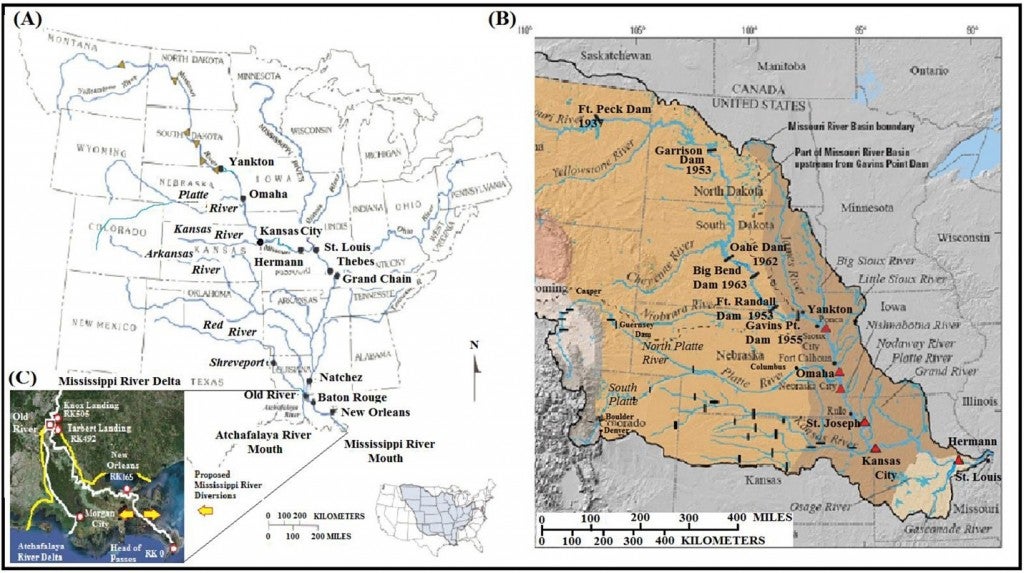Reconnecting the Delta: How Increased Mud Supply Can Improve Sediment Diversions
Jordan Davis, Mississippi River Delta Restoration Science Intern, Environmental Defense Fund
Rising sea level and anthropogenic sediment loss is a combination affecting sustainability of deltaic ecosystems. Around the world, major deltas have been experiencing a 44% decline in sediment supply since the 1950s due to construction of dams and reservoirs, including the Mississippi River Delta. A recent journal article, published in Estuarine, Coastal and Shelf Science, examined the role of fine-grained sediments in deltaic restoration. The authors found that the supply of suspended mud (silt and clay) to the coast has dropped from a mean of 390 Mt y-1 (megatonnes per year) to just 100 Mt y-1 since 1970. These fine-grained sediments play a crucial role in estuarine ecosystems by sustaining existing marshes.
Almost 100 dams, built as part of the Pick-Sloan water development project, trap mud that once flowed from the Missouri River Basin, resulting in high erosion of very fine sediment, known as loess, in both the eastern and western bank tributaries. Five large reservoirs eliminated sediment from 53% of the watershed. This loss of sediment, with the loss of deltaic wetlands, has hit Louisiana especially hard, and this continued decline in fine-grained sediment flux from the Mississippi River is more important than ever.

(1) (A) Suspended sediment sampling stations in the Mississippi River watershed, modified from Meade and Moody (2010). (B) USGS sediment sampling stations (red triangles) and large dams along the Missouri River Basin, modified from Alexander et al. (2013). (C) Mississippi River Delta Plain and proposed sites of large diversions (Coastal Protection and Restoration Authority, 2012). Image from Kemp et al. 2016.
The wetlands of the Mississippi River Delta are rapidly shrinking. Since 1923, almost 1,250,000 acres have been lost to open water. Initiatives to stop this loss are underway; the Coastal Master Plan calls for at minimum two large (75,000 cubic feet per second) controlled sediment diversions, engineered to encourage land building by reconnecting the lower Mississippi River to its delta.

(2) Annual total suspended sediment and suspended sand loads in the Mississippi River at Tarbert Landing showing relationship between 1950-1969 and 1970-2013, modified from Meade and Moody (2010). Image modified from Kemp et al. 2016
The Mississippi River is naturally effective at building land. Over the last 7,000 nearly 25,000 square miles of new land were built in the delta. Sediment diversions mimic the natural processes that originally built coastal Louisiana by reconnecting the river to its wetlands. Sand transport via sediment diversions allows wetland building in shallow, sheltered coastal bays. However, the finer grained mud that is necessary to sustaining existing marshes will still need to play a role in restoration.
According to the authors of the study, 66% of the missing mud lies in reservoirs on the lowest Missouri River tributaries. Increased mud supply to the delta is possible. The authors found that bypassing 100 Mt y-1 of mud around the dams would increase Mississippi River delta sediment supply within 1-2 decades, and such measures are compatible with the objectives of the Missouri River Restoration and Platte River Recovery Program. Additionally, the authors believe that more mud would enhance river diversions, making them more effective.
Undoubtedly, extensive regional coordination and funding is needed to move fine-grained sediments past as many as 50 Lower Missouri River tributary dams. However, the deterioration of the Mississippi River Delta is so rapid that to just sustain a fraction of the landmass, engineered river diversions and an increase in mud supply are necessary.
Jordan Davis is a summer intern at the Environmental Defense Fund working with the Mississippi River Delta Restoration team. Jordan is a junior at the College of Charleston majoring in geology and minoring in environmental science. Jordan is interested in coastal geology and is excited to apply what she has learned at the Environmental Defense Fund to problems in Charleston; this fall, she will be working on local beach restoration initiatives in the area.